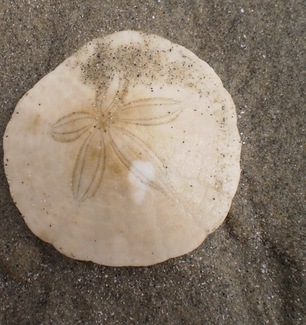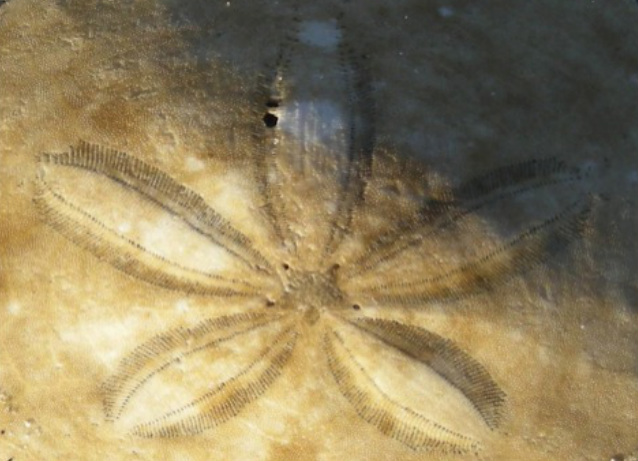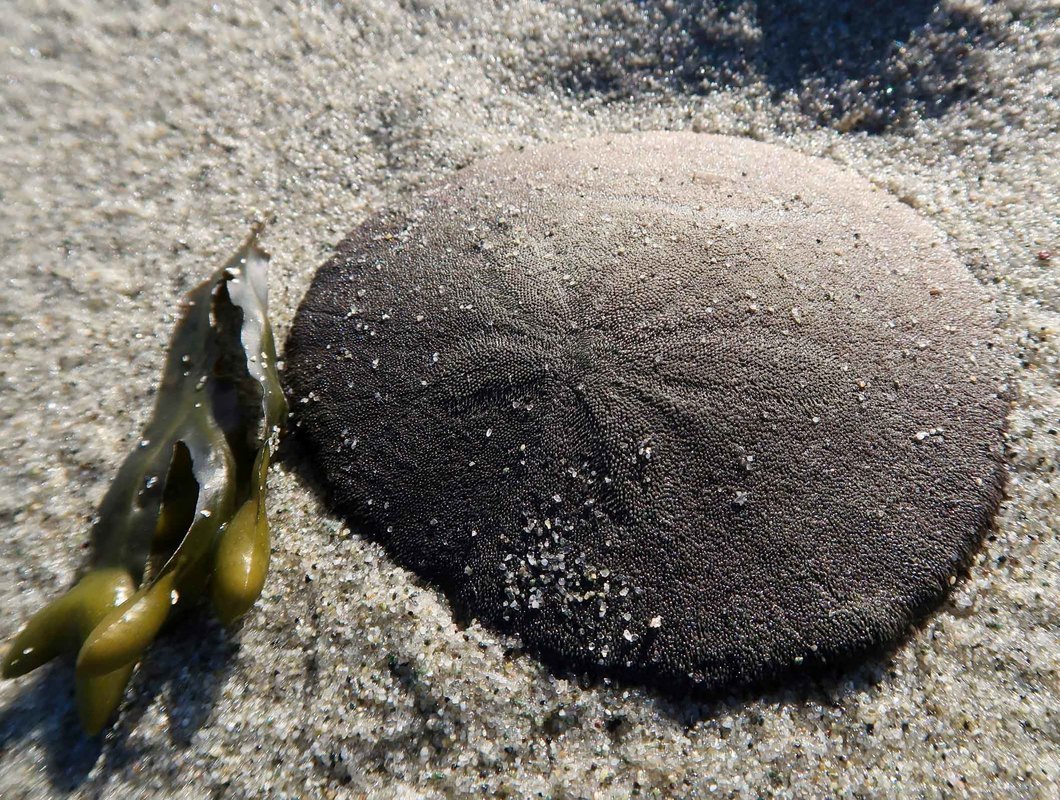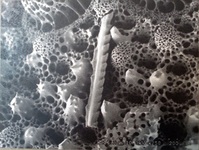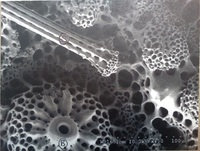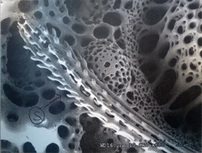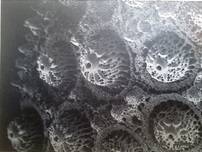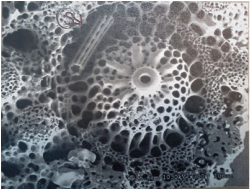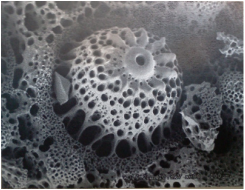Eccentric sand dollar, Pacific sand dollar, common sand dollar, west coast sand dollar, sand cookie, sea biscuit • Dendraster excentricus
{Dendr = tree, aster = star, excentricus = off centre}
Identification
A live sand dollar is dark grey, brown, or purplish-black in colour, but a casual beach-goer is much more likely to come across the white or light grey coloured test (shell). The top of a live sand dollar and its test bears the shape of a off-centre five-petaled flower (petalidium). This petaloid structure is actually a series of tiny holes in the test; specialized tube feet emerge from these holes, and are used for respiration. The test is covered in tiny spines (to 2 mm long) that are used for eating, burrowing, and moving. Individuals can reach 10 cm in diameter. Click here for a video of a live sand dollar.
Habitat & Range
This species is found in the intertidal and subtidal (to 40 m deep) of sandy shorelines, though it most commonly inhabits shallower subtidal areas. Individuals that live intertidally will burrow down into wet sand when the tide goes out, to wait out the dry spell between tides. The eccentric sand dollar is found from southern Alaska to northern Mexico.
Similar Species
This is the only species of sand dollar found commonly along the central coast of BC. The more northern species Echinarachnius parma (found in Alaska, the Arctic, and occasionally BC) is flatter, and its petalidium is more symmetrical and centred.
Intriguing Info
Sand dollars aggregate underwater, and usually orient themselves according to currents. This orientation will either occur while lying flat or while standing on edge, partially buried in sand. Click here to read more about sand dollar aggregations.
Sand dollars live for 6-8 years; the age of an individual can be determined by counting the growth rings on its test. Young sand dollars can make themselves heavier when facing strong currents by swallowing grains of sand.
iNaturalist
https://www.inaturalist.org/taxa/117696-Dendraster-excentricus
A live sand dollar is dark grey, brown, or purplish-black in colour, but a casual beach-goer is much more likely to come across the white or light grey coloured test (shell). The top of a live sand dollar and its test bears the shape of a off-centre five-petaled flower (petalidium). This petaloid structure is actually a series of tiny holes in the test; specialized tube feet emerge from these holes, and are used for respiration. The test is covered in tiny spines (to 2 mm long) that are used for eating, burrowing, and moving. Individuals can reach 10 cm in diameter. Click here for a video of a live sand dollar.
Habitat & Range
This species is found in the intertidal and subtidal (to 40 m deep) of sandy shorelines, though it most commonly inhabits shallower subtidal areas. Individuals that live intertidally will burrow down into wet sand when the tide goes out, to wait out the dry spell between tides. The eccentric sand dollar is found from southern Alaska to northern Mexico.
Similar Species
This is the only species of sand dollar found commonly along the central coast of BC. The more northern species Echinarachnius parma (found in Alaska, the Arctic, and occasionally BC) is flatter, and its petalidium is more symmetrical and centred.
Intriguing Info
Sand dollars aggregate underwater, and usually orient themselves according to currents. This orientation will either occur while lying flat or while standing on edge, partially buried in sand. Click here to read more about sand dollar aggregations.
Sand dollars live for 6-8 years; the age of an individual can be determined by counting the growth rings on its test. Young sand dollars can make themselves heavier when facing strong currents by swallowing grains of sand.
iNaturalist
https://www.inaturalist.org/taxa/117696-Dendraster-excentricus
The very fine texture of a sand dollar test is visible in these high-magnification photos, taken with a scanning electron microscope (SEM). The spines attach to and rotate on the raised bumps clearly seen in the right hand photos, in a ball-and-socket type of joint. Photos taken by Kelly Fretwell, assisted by Brent Gowenat the Electron Microscopy Lab in the Biology department of UVic.
References
Cowles, D. (2006). Dendraster excentricus (Eschscholtz, 1831). Invertebrates of the Salish Sea. Rosario Beach Marine Laboratory. Accessed 22/06/2013
Harbo, R. M. (1999). Whelks to whales: Coastal marine life of the Pacific Northwest. Madeira Park, BC: Harbour Publishing. P. 146
Lamb, A., and Hanby, B. (2005). Marine Life of the Pacific Northwest. Madeira Park, BC: Harbour Publishing. P. 339
Sand Dollar. Monterey Bay Aquarium. Monterey Bay Aquarium Foundation. Accessed 22/06/2013
Authors and editors of page
Kelly Fretwell and Brian Starzomski (2013).
Cowles, D. (2006). Dendraster excentricus (Eschscholtz, 1831). Invertebrates of the Salish Sea. Rosario Beach Marine Laboratory. Accessed 22/06/2013
Harbo, R. M. (1999). Whelks to whales: Coastal marine life of the Pacific Northwest. Madeira Park, BC: Harbour Publishing. P. 146
Lamb, A., and Hanby, B. (2005). Marine Life of the Pacific Northwest. Madeira Park, BC: Harbour Publishing. P. 339
Sand Dollar. Monterey Bay Aquarium. Monterey Bay Aquarium Foundation. Accessed 22/06/2013
Authors and editors of page
Kelly Fretwell and Brian Starzomski (2013).
